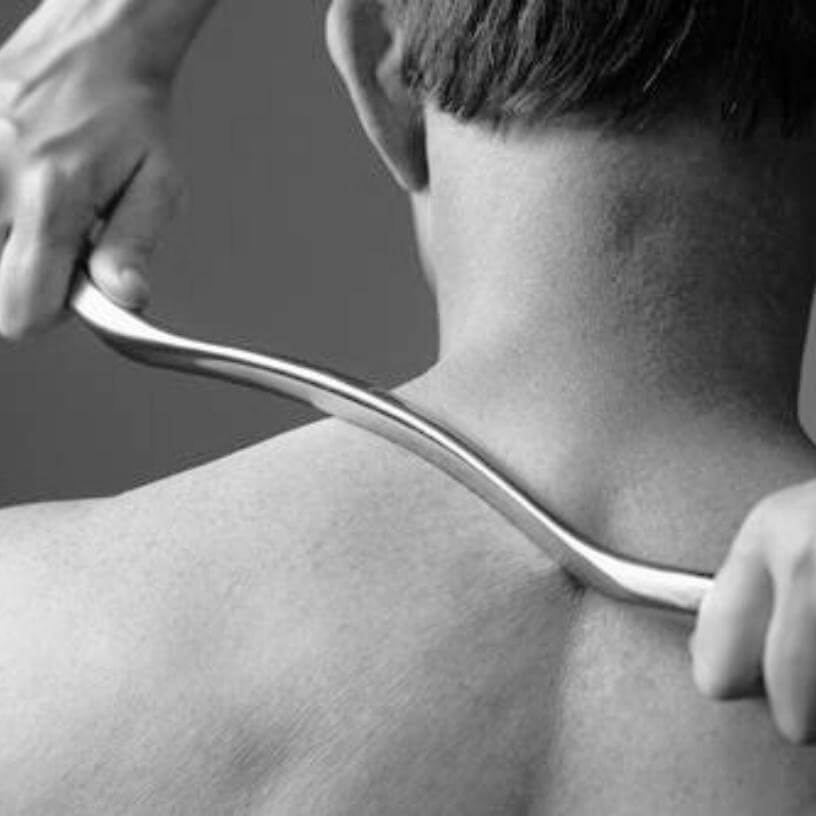Graston Technique®: What Is It And How Can It Help My Pain?

Graston Technique® (GT) has been gaining traction in the physical therapy world over the past decade or so, and with good reason. Graston Technique® is an instrument assisted soft tissue mobilization technique used to break down fascial adhesions, scar tissue and trigger points, to restore normal function to a target tissue. Graston Technique® allows the clinician to better assess tissue texture through the use of stainless steel instruments, rather than using one’s hands. The instruments are combed along the skin surface similar to a traditional hand massage, though GT is typically much more comfortable for both the patient and the practitioner than using the hands, including during more aggressive techniques such as trigger point release. Graston Technique® can be used on any muscle in the body, but a few of the more common applications seen in the clinic will be discussed in this article.
Graston Technique® is utilized to cause micro-trauma to the target tissue via friction, which restarts the healing process, beginning with the inflammatory process. The inflammatory process lasts 2-3 days, during which time the body brings white blood cells, nutrients and growth factors to the area. Following the inflammatory process, the cells enter the proliferation phase which lasts for 2-3 weeks, when fibroblasts work to produce new collagen to begin healing in the area. After that, the cells in the area enter the maturation phase, when the collagen fibers are remodeled to their ideal type. Graston Technique® facilitates this process much more effectively than the hands, due to the sensitivity of the instruments and the beveled edge on the instrument to improve contact with the target tissue. Graston Technique® has also been shown to break down collagen cross-links (scar tissue and adhesions) via microscope study. Typical treatment using GT is around 2 times per week for 8 minutes per session and should not result in bruising. Next, we will discuss a few common conditions that respond well to GT.
Plantar fasciitis is a condition involving aggravation of the plantar fascia, a ligamentous structure on the underside of the foot that runs from the heel to the toes and provides support to the arches. The plantar fascia can become aggravated if a person has excessive ankle pronation (rolling inwards), tight calves, flat feet or unstable ankles. Any of the aforementioned conditions can place added strain on the plantar fascia, which may lead to micro-tears in the plantar fascia and/or thickening (scar tissue) of the plantar fascia, both of which cause pain. Graston Technique® is a very effective treatment for plantar fasciitis when used in conjunction with stretching and strengthening. Following GT, the patient will perform stretching to the plantar fascia and Achilles tendon, as well as specific strengthening exercises for the toe flexors, calves and supporting ankle musculature.
Achilles tendonopathy is another condition that responds very well to GT when combined with traditional physical therapy plans of care. Achilles tendonopathy is similar to plantar fasciitis in that it is caused by micro-tears to the tendon, typically from overuse, poor running technique, improper footwear or running on inclined surfaces. Achilles tendonopathy typically presents with pain in the lower portion of the Achilles tendon, though it can also affect the muscles of the calf (gastrocnemius and soleus) if the symptoms remain untreated. Graston Technique® is utilized on the Achilles tendon from all angles, including the underside. Additional focus is placed on the medial and lateral gastrocnemius heads, both of which can develop trigger points, causing the muscles to function at sub-optimal levels. Following GT, the patient will perform stretching for the gastrocnemius and soleus muscles, as well as eccentric strengthening to focus on re-aligning collagen fibers within the Achilles tendon.
Medial epicondylitis (Golfer’s Elbow) and lateral epicondylitis (Tennis Elbow) are also excellent examples of injuries that respond very well to GT. Both of these conditions are typically caused from overuse and overstressing the muscles of the forearm. Pain is experienced during lifting, twisting, and gripping activities of the arm. Typically the patient will develop tightness through the forearm muscles and will have numerous trigger points through the affected muscles. Graston Technique® is used for trigger point release, as well as general stroking techniques to help with muscle fiber alignment and to increase blood flow to target musculature. The patient will follow GT with stretching of target muscles and eccentric strengthening of the same muscle group.
These are just a few of the more common applications of Graston Technique® seen in the physical therapy clinic, though it can be used on many conditions with a soft tissue component.
Request an Appointment at Proclinix Sports Physical Therapy & Chiropractic
1 comment
Comments are closed.


Reading your article has greatly helped me, and I agree with you. But I still have some questions. Can you help me? I will pay attention to your answer. thank you.